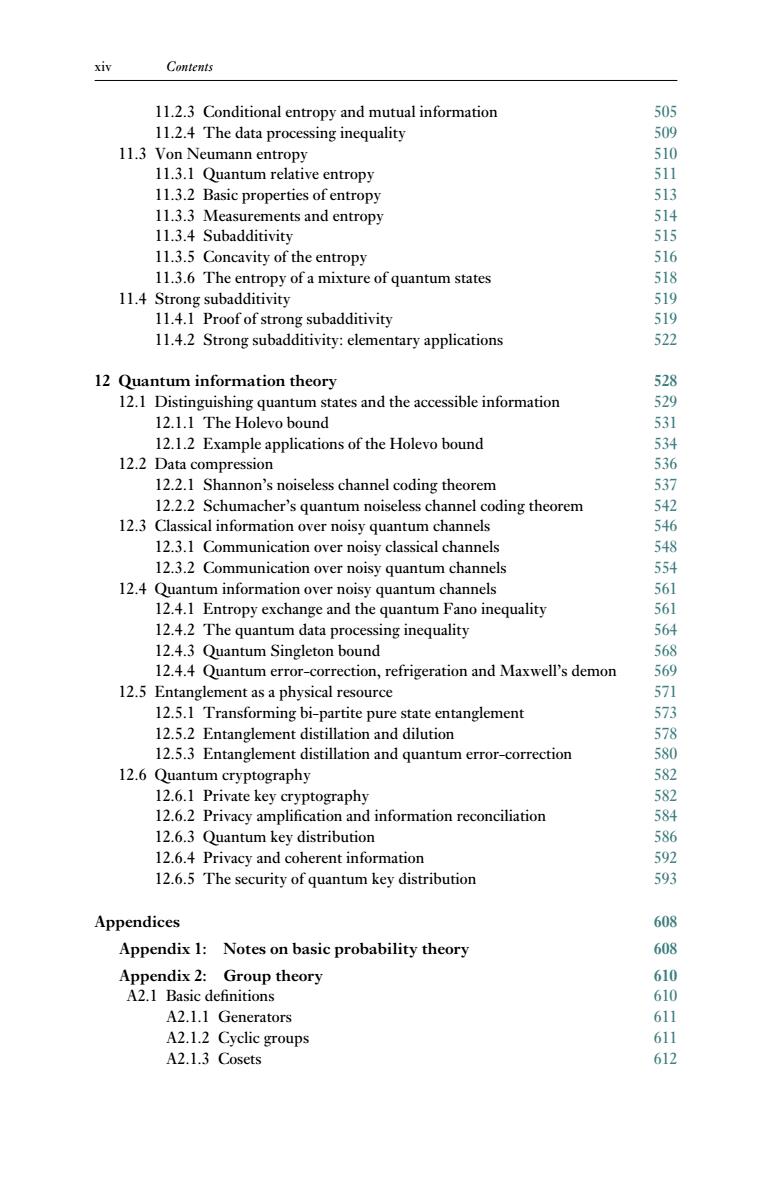正在加载图片...

xiv Contents 11.2.3 Conditional entropy and mutual information 505 11.2.4 The data processing inequality 509 11.3 Von Neumann entropy 510 11.3.1 Quantum relative entropy 511 11.3.2 Basic properties of entropy 513 11.3.3 Measurements and entropy 514 11.3.4 Subadditivity 515 11.3.5 Concavity of the entropy 516 11.3.6 The entropy of a mixture of quantum states 518 11.4 Strong subadditivity 519 11.4.1 Proof of strong subadditivity 519 11.4.2 Strong subadditivity:elementary applications 522 12 Quantum information theory 528 12.1 Distinguishing quantum states and the accessible information 529 12.1.1 The Holevo bound 531 12.1.2 Example applications of the Holevo bound 534 12.2 Data compression 536 12.2.1 Shannon's noiseless channel coding theorem 537 12.2.2 Schumacher's quantum noiseless channel coding theorem 542 12.3 Classical information over noisy quantum channels 546 12.3.1 Communication over noisy classical channels 548 12.3.2 Communication over noisy quantum channels 554 12.4 Quantum information over noisy quantum channels 561 12.4.1 Entropy exchange and the quantum Fano inequality 561 12.4.2 The quantum data processing inequality 564 12.4.3 Quantum Singleton bound 568 12.4.4 Quantum error-correction,refrigeration and Maxwell's demon 569 12.5 Entanglement as a physical resource 571 12.5.1 Transforming bi-partite pure state entanglement 573 12.5.2 Entanglement distillation and dilution 578 12.5.3 Entanglement distillation and quantum error-correction 580 12.6 Quantum cryptography 582 12.6.1 Private key cryptography 582 12.6.2 Privacy amplification and information reconciliation 584 12.6.3 Quantum key distribution 586 12.6.4 Privacy and coherent information 592 12.6.5 The security of quantum key distribution 593 Appendices 608 Appendix 1:Notes on basic probability theory 608 Appendix 2:Group theory 610 A2.1 Basic definitions 610 A2.1.1 Generators 611 A2.1.2 Cyclic groups 611 A2.1.3 Cosets 612xiv Contents 11.2.3 Conditional entropy and mutual information 505 11.2.4 The data processing inequality 509 11.3 Von Neumann entropy 510 11.3.1 Quantum relative entropy 511 11.3.2 Basic properties of entropy 513 11.3.3 Measurements and entropy 514 11.3.4 Subadditivity 515 11.3.5 Concavity of the entropy 516 11.3.6 The entropy of a mixture of quantum states 518 11.4 Strong subadditivity 519 11.4.1 Proof of strong subadditivity 519 11.4.2 Strong subadditivity: elementary applications 522 12 Quantum information theory 528 12.1 Distinguishing quantum states and the accessible information 529 12.1.1 The Holevo bound 531 12.1.2 Example applications of the Holevo bound 534 12.2 Data compression 536 12.2.1 Shannon’s noiseless channel coding theorem 537 12.2.2 Schumacher’s quantum noiseless channel coding theorem 542 12.3 Classical information over noisy quantum channels 546 12.3.1 Communication over noisy classical channels 548 12.3.2 Communication over noisy quantum channels 554 12.4 Quantum information over noisy quantum channels 561 12.4.1 Entropy exchange and the quantum Fano inequality 561 12.4.2 The quantum data processing inequality 564 12.4.3 Quantum Singleton bound 568 12.4.4 Quantum error-correction, refrigeration and Maxwell’s demon 569 12.5 Entanglement as a physical resource 571 12.5.1 Transforming bi-partite pure state entanglement 573 12.5.2 Entanglement distillation and dilution 578 12.5.3 Entanglement distillation and quantum error-correction 580 12.6 Quantum cryptography 582 12.6.1 Private key cryptography 582 12.6.2 Privacy amplification and information reconciliation 584 12.6.3 Quantum key distribution 586 12.6.4 Privacy and coherent information 592 12.6.5 The security of quantum key distribution 593 Appendices 608 Appendix 1: Notes on basic probability theory 608 Appendix 2: Group theory 610 A2.1 Basic definitions 610 A2.1.1 Generators 611 A2.1.2 Cyclic groups 611 A2.1.3 Cosets 612